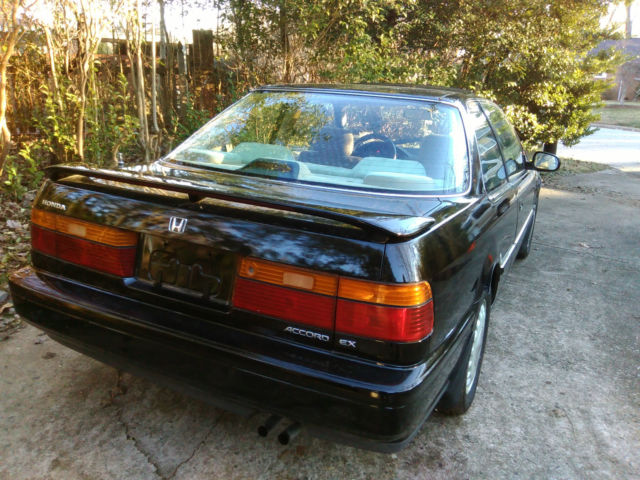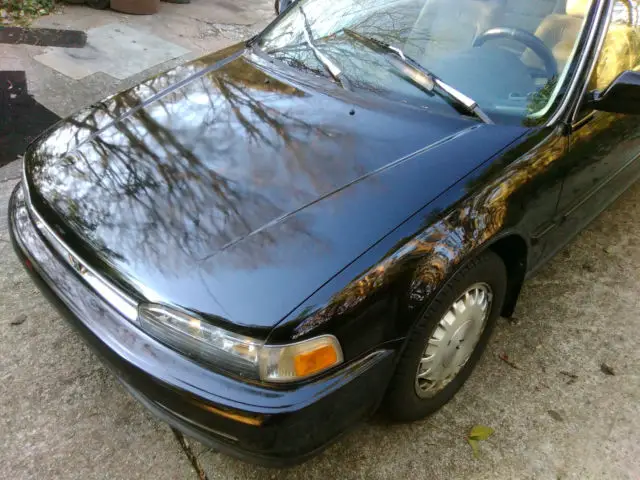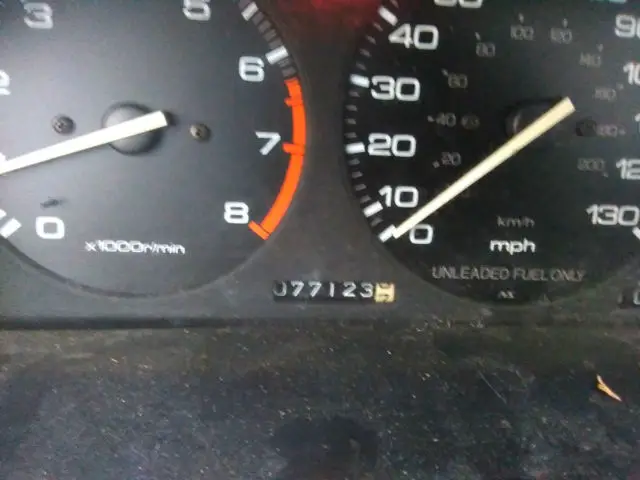*Honda Accord EX 1990 2-dr Front wheel drive Moonroof Rear spoiler Alloy Wheels*
| Make: | Honda |
| Model: | Accord |
| SubModel: | E X |
| Type: | Coupe |
| Trim: | E X |
| Year: | 1990 |
| Mileage: | 77,123 |
| VIN: | 1HGCB726XLA010522 |
| Color: | Black Pearl |
| Engine: | 2.2L |
| Cylinders: | 4 |
| Fuel: | Gasoline |
| Transmission: | Automatic w/ Sportshift |
| Drive type: | FWD |
| Interior color: | Tan |
| Vehicle Title: | Clear |
| Item location: | Greensboro, North Carolina, United States |
| Extras |
|
Mirrors, Moonroof, Air Conditioning, Cruise Control, Power Windows Moonroof, Alloy Aluminum Wheels, Rear spoiler w/ Brake Light Bar, Cassette Player |
| Listed by | Private seller |
Description of 1990 Honda Accord E X |
|
Up for sale is an excellent 1990 Honda Accord EX with a Black Exterior and Tan upholstery inside. This is a 1990 HONDA ACCORD EX 2-Door Coupe with extremely low original mileage. Elderly mom car, recently passed, passed to son, hence two owner's, same family, same location. Car is in very good condition for its age. It has not been in an accident. Excellent gas mileage and is a very reliable car, nothing major breaks down, just common things, battery, etc. Has been cared for and well maintained. Timing belt and other related components associated with this procedure were replaced as part of a suggested preventative maintenance initiative. It is now considered a classic (see Haggerty >20 years old) and will continue to increase in value. Sold as is * Sale is final * No returns ----------------------------------------------Ancillary Honda Accord Model Information: HONDA ACCORDFourth generation (1990–1993) The 4th generation Accord, introduced on the "CB" chassis, was unveiled in 1989. Although much larger than its predecessor the sedan's styling was evolutionary, featuring the same low slung design and wraparound rear window as the 3rd generation Accord. For the first time a 3-door hatchback was no longer available internationally. This was one of the first U.S. production cars to feature optic reflectors with completely clear lenses on the headlamps. For this fourth generation Accord, Honda made significant engineering design improvements. All Accords sold in North America came with a completely new all aluminium 2.2-liter 16-valve electronic fuel-injected engine standard, replacing the previous 2.0-liter 12-valve model from the past generation. Also noteworthy, all Accords equipped with automatic transmissions used an electronically controlled rear engine mount to reduce low frequency noise and vibration. The mount contained two fluid filled chambers separated by a computer controlled valve. At low engine speeds, fluid is routed through the valve damping vibration. Above 850 rpm, fluid is routed around the valve making the engine mount stiffer. In the U.S., the LX-i and SE-i designations were dropped, being replaced with the DX, LX, and EX trim levels. A 125-horsepower (93 kW) 4-cylinder engine was offered in the DX and LX models (F22A1), while the 1990 and 1991 EX received a 130 hp (97 kW) version (F22A4). Cruise control was dropped from the DX sedan, with air conditioning remaining a dealer-installed option. The LX kept the same features as the previous generation including air conditioning, power windows, door locks, and mirrors. The 90–91 EX added 5 horsepower due to a different exhaust manifold design, slightly larger exhaust piping and a twin outlet muffler. 15-inch machined aluminum-alloy wheels, moonroof, upgraded upholstery, rear stabilizer bar and a high-power 4-speaker stereo cassette were standard on all EX models. Some models though rare were special ordered with an anti-lock braking system (at that time abbreviated as ALB, now all automakers refer to it as ABS). A redesigned manual transmission with a hydraulic clutch was standard equipment in all trims while an all-new electronically controlled 4-speed automatic transmission was optional for all models. Because of tightening auto safety regulations from the NHTSA, all 1990 and 1991 Accords sold in the United States came equipped with motorized shoulder belts for front passengers to comply with passive restraint mandates. These semi-automatic restraints were a two component system; a motorized shoulder belt along with a non-integrated and manually operated seatbelt. The shoulder belts automatically raced around each window frame encircling both the driver and front seat passenger whenever the front door closed. The process reversed to release them when opened. The lap belts however, still required manual fastening. |
 Home
Home Contact us
Contact us NEWEST CARS
NEWEST CARS SELL YOUR CAR
SELL YOUR CAR FAQ
FAQ














